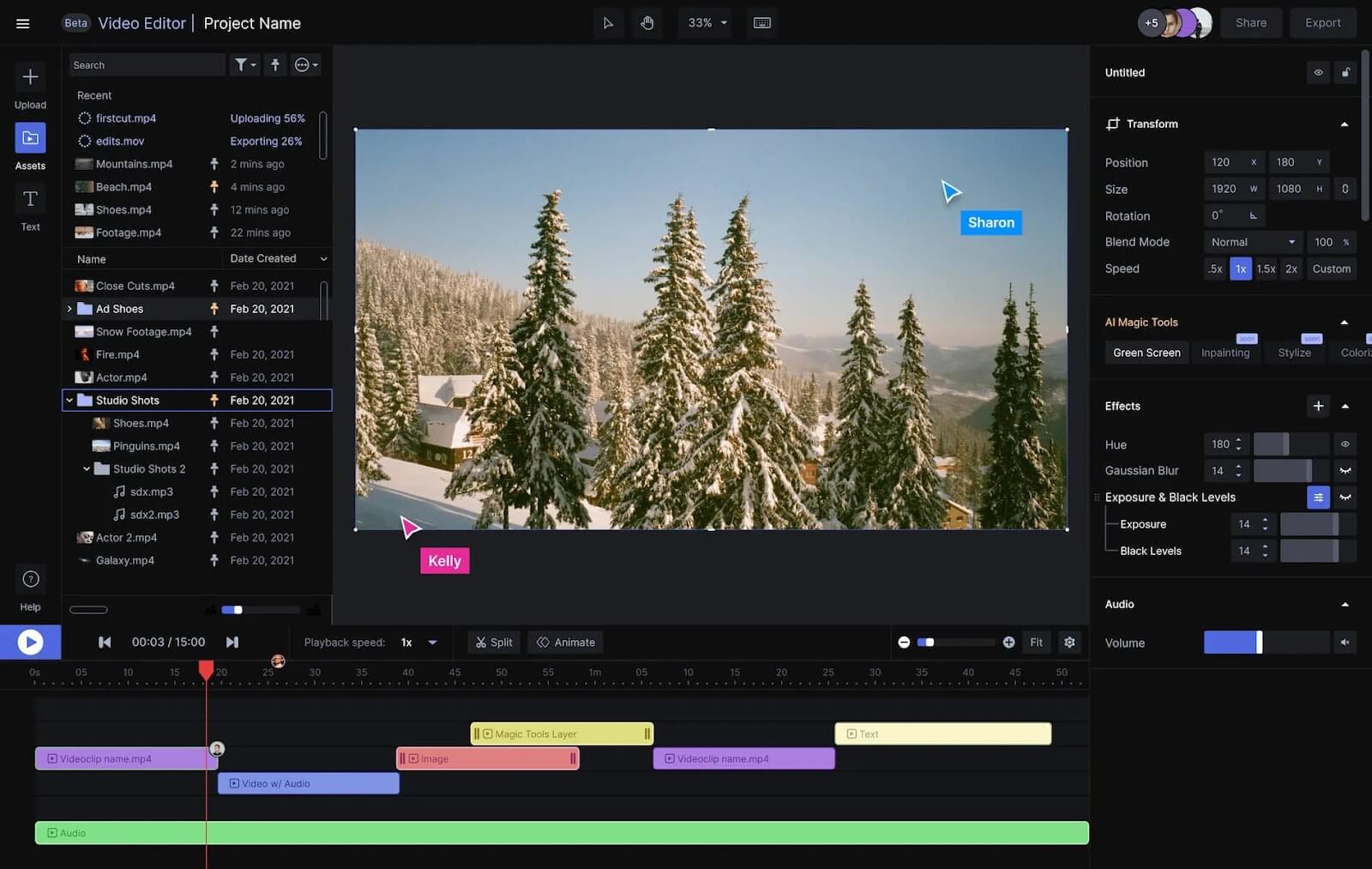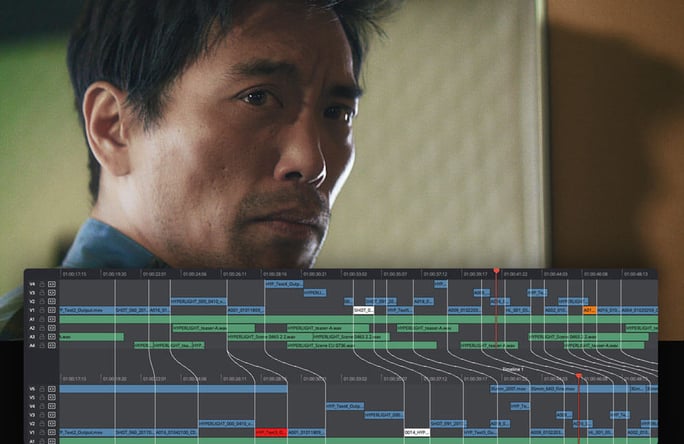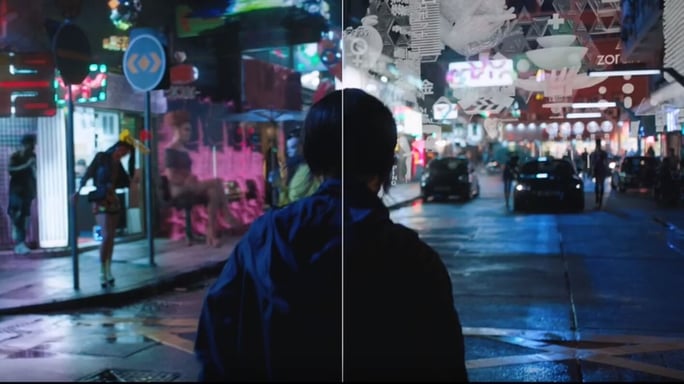There is no other way to edit video than to sit in front of a large, powerful PC and get to work. Or, at least, that’s what we’re used to. However, the new reality is that the cloud is changing how we edit and the tools needed to get the job done. Though editing rigs are here to stay for the foreseeable future, cloud-based technologies such as cloud storage, remote access, collaborative cloud reviewing, and cloud-based NLEs are quickly changing the landscape.
As the country shifts to remote and hybrid working schedules to accommodate employees and save on overhead, it’s only natural that post-production trends in the same direction. Productions using cloud-based technologies and solutions are more collaborative and adaptable. And if the COVID-19 pandemic taught the industry anything, it’s that you have to be ready to adapt.
What are cloud-based NLEs?
A cloud-based NLE, or non-linear editor, is a type of video editing software that works via the cloud. While “the cloud” has been around for a long time now, the proliferation of cloud-based NLEs is just beginning. On the one hand, you have web-based software like Blackbird, which is accessible via browser from essentially any machine with a web browser. Blackbird, and other software like it, manages everything from software storage to computer power to rendering and publishing directly to video platforms. It’s an all-in-one solution used by TV networks, such as A&E and Univision, and sports organizations, such as the NHL and Arsenal FC, for live TV broadcasting.
Other up-and-coming cloud-based NLEs such as Capsule, Flixier, and Runway, just to name a few, are also available to use via web browser. These lightweight web-based NLEs still have plenty of cloud features and don’t require expensive equipment to get up and running. Some platforms like Adobe Express and Capsule offer simple drop-in templates to create branded videos or social content. Others, like Flixier and Runway, provide a more traditional NLE-style platform with multitrack editing and cloud support for simultaneous collaboration. These platforms lend themselves well for uncomplicated projects and don’t require tons of editing experience, but for more involved projects, you need something beefier.

Runway is a fully-fledged, multi-track NLE with cloud features, and it works on any browser. Image via Runway.
That something is DaVinci Resolve 18. Blackmagic’s NLE is well-known and is as popular with amateurs as it is with professionals due to its inclusion of almost every aspect of the post-production workflow. From media management to editing to VFX and, what it’s best known for, color grading, anything you want to do in Resolve is a tab away. Its free-to-download business model is sure to explain some of its popularity, but not all of it; the real reason is that DaVinci Resolve did everything. Well, everything but cloud-based editing. That’s changed, however, with the release of Davinci Resolve 18. The new update brings a slew of changes that implement cloud-based editing into every aspect of the editing pipeline.
Instead of a traditional setup where multiple editors tackle different aspects of the workflow on their own machines, Resolve 18 merges all those instances into one. Now, editors, colorists, VFX artists, and audio engineers can work on the same timeline, with each person sequestered in a different tab to work together in real-time. It’s nothing short of revolutionary, and the innovations could eliminate a lot of bottlenecks.

Similar to comparing new and old versions on Google Docs, visual timeline comparison shows new changes in an easily digestible way. Image via Blackmagic Design.
For example, multiple editors could work on separate parts of the timeline while their supervisors made comments in real-time that could be discussed via chat and addressed instantly — nobody is going to complain about fewer Slack messages and emails. Better yet, the new visual timeline comparison feature shows where exactly clips were added, cut, or moved. As this is happening, everyone’s computers automatically sync with the cloud via Dropbox and cache files locally for faster access. And down the pipeline in the Color tab, colorists (yes, plural) could be tackling grades at the pace of clips at a time, with the software tracking who’s working on what and locking the clips to prevent accidental overwrites. Whereas before Resolve was an all-in-one machine, the latest update turns it into a factory, with each tab humming with activity.
The full list of new features is exhaustive and much too large to explain individually, but the gist of it is this: DaVinci Resolve 18 has set the bar. In turn, it could push other NLE software makers to beef up their software with more cloud-based features.

Post-Production Workflow Template
Use our professional post-production schedule and workflow template to plan, share and revise your post schedule.
Get Template
Cloud-based editing infrastructure is booming
DaVinci Resolve 18 is cloud-ready, but that doesn’t rule out other desktop-based NLEs from cloud editing. Thanks to emerging cloud technologies, cloud-based editing is happening all around the industry . While your chosen NLE may not be accessible via a web browser or capable of cloud editing, plenty of solutions can work around that. Companies like EditShare, ProMAX and Teradici are just a few leveraging the power of the cloud for remote, cloud-based editing.
EditShare and ProMAX offer different cloud technologies that are no less useful. The two provide cloud storage, media management, virtual workstation integrations, and scalable network-attached storage servers. Servers allow teams to store projects on-site that are accessible to both editors working in the office or remotely, which saves on overhead by not having to shell out for expensive cloud storage subscription fees. Blackmagic also offers cloud storage and storage servers, though Blackmagic’s storage servers can sync with Dropbox, which saves files onto your local machine for faster access.
On the VFX side, Nvidia is leveraging its RTX GPU architecture with its new Omniverse project. Nvidia Omniverse promises to connect the myriad software used by 3D artists, which will make the process more efficient by removing the need to frequently export and import files from one software to another. It will also allow creators to work together on 3D rendering software like Blender, Autodesk, Daz3D and more. Even creators without access to an RTX-powered computer will be able to tap into the power of Nvidia Omniverse by streaming a desktop instance via the cloud-streaming gaming platform, GeForce Now.
The technology only became public recently, but its practical applications range from 3D animation to 3D modeling to real-word physics simulations. The RTX architecture is the core technology, but Nvidia’s GPU computing data center makes it scalable; Pixar’s open-source USD makes 3D software play nice with each other; AI and machine learning handle complex physics simulations. As an enterprise solution, it’s already in use by Amazon, Siemens, BMW and Lockheed Martin for physics simulations. The ways in which the Nvidia Omnivese can be implemented is truly head-spinning. For VFX studios, which typically work on tight deadlines, this could mean faster turnarounds and better margins.
Of course, these technologies are not cloud-based NLEs, but they aid in the process of editing remotely via the cloud. Post-production practices won’t change overnight, but cloud-based technologies are undoubtedly becoming more common.
More productions are using the cloud than before
Cloud technologies, and cloud-based editing, for that matter, are not new, but the need to work remotely during the pandemic suddenly made cloud technologies more appealing. It should go without saying that safety is paramount for everyone’s health and well-being, but also for the financial success of the project. The spread of the virus led to many production shutdowns that dealt a huge blow to the industry. Even productions that implemented professional levels of COVID-19 precautions were not immune from talent contracting the virus. For example, when Robert Pattinson became sick with the virus, the production of The Batman shut down for weeks. Similar incidents occurred across the industry, leaving companies scrambling for an alternative.
The pandemic was a wake-up call. This resulted in production halts and many films produced with limited casts in a single location or filmed through videoconferencing. Films like Micheal Bay’s Songbird captured a pandemic in a dystopian setting while the COVID-19 pandemic was still in full swing, using cloud systems to send footage from the camera and into media management software. This enabled faster turnarounds in post-production while reducing contact between staff.

One of the earliest pandemic movies about the pandemic, Songbird, used cloud tech to improve on-set workflows. Image via Peacock.
Folks on the post-production side caught a break as they were better able to adapt via the use of cloud-based technologies and platforms. In a Rolling Stone article written by post-production executive Domenic Rom, he explained how his company was able to move from the office to employees’ homes before New York City officially shut down. Thanks to the cloud, others were able to move their teams online and continue operating at a time when whole industries shut down. A UK-based post-production supervisor was quoted in a Screen Daily article, saying her team shifted workflows to work remotely by using cloud-based apps for client video review, and using other cloud-based technologies to edit, mix, and color grade footage.
Smaller-scale post-production teams, which don’t have the budget of bigger companies, rely on cloud computing to achieve shots with almost unfathomable levels of detail. The equipment needed to render industry-leading VFX shots comes with a steep price tag that more modest outfits can’t afford. That’s where third-party cloud rendering services like Conductor, Rayvision, Amazon’s AWS Thinkbox, TurboRender, and others, come in.

VFX being added to the scene with Conductor. Image via Conductor.
These “render farms,” as they’re sometimes called, take on the heavy burden of rendering by letting customers tap into the power of cloud computing, with scalable solutions that can serve small teams as well as larger ones. Since the technology can be scaled according to the project, clients only pay for what they use.
It’s such a necessary tool for post-production outfits that it’s used on the biggest blockbusters and TV shows. Just to name a few: Shang-Chi and the Legend of the Ten Rings, Game of Thrones, Deadpool, Star Trek Beyond, Love Death + Robots, and The Wandering Earth. With margins being what they are in the post-production industry, it wouldn’t be incorrect to assume cloud rendering is helping smaller teams stay open for business. In an article from the BBC, a computer graphics supervisor for the post-production company Atomic Fiction said as much, claiming it would be “impossible” for his company to compete with larger players without third-party cloud computing.

One of the latest Marvel movies was rendered with Conductor. Shang-Chi and the Legend of the Ten Rings, image via Disney+.
The lessons learned in the pandemic are not going anywhere. The benefits gained from online workflows that use the cloud are too good to pass up. Instead of the post-production industry shrinking in the aftermath of the pandemic, analysts predict the market will grow exponentially in the next few years. According to the analytics firm Research Dive (via GlobeNewswire), the post-production industry is projected to grow to over $25 billion by 2026 from a modest $8 billion back in 2020. The report points to cloud-based technologies as a key factor in this growth, writing, “the implementation of the cloud in the post-production stage is expected to boost the growth of the market...”
Moving away from the office has its drawbacks, such as less spontaneous collaboration and bonding between team members. As for management, the lack of direct supervision can cause uneasiness with respect to efficiency. However, the upside of going remote or hybrid is not to be ignored. A Variety article reported that “nearly 80% of ViacomCBS’ more than 20,000 staffers will work in a hybrid environment after the pandemic.”
Though not every production company will implement remote or hybrid protocols, the pandemic clearly caused ripples in how the business of making films operates. In the same article, the CEO of Industrial Media, Eli Holzman, credited the shift to cloud-based editing systems as a reason to look for top talent globally. Holzman said his company “hired lots of people that we’d never met in person... there is a great opportunity to work with people from around the world.”
Cloud-based technologies and their effect on remote work
It should also be noted how much companies can save on overhead. Office space can be diminished or outright eliminated with fully-remote or hybrid teams. The money saved on cutting exorbitant multi-year leases also affects the employee burn rate, which is the money that companies spend on each employee every month, including salary, insurance, gear, and miscellaneous items. Having fewer, or no, employees at the office equates to less money spent on free lunches, events, appliances, utilities, and support staff. Instead, that money can go to help employees directly, such as investing in mental health programs, gym memberships or subscriptions to workout apps, and stipends that employees can use for self-care. Yes, cloud-based technologies are expensive to implement, but are they more expensive than working in the office? That depends on the size of the company and other factors. Still, with employees embracing a remote-working lifestyle, companies can’t afford to lose top talent over something as trivial as employees’ preference to work from home.
Not every industry has the privilege to shift to remote working, but the post-production industry has cloud technologies to thank for that. They’re convenient, scalable, and adaptable to changing circumstances. From small-time content teams to big-budget film productions and everyone in between, the continued innovation in cloud technologies has enabled teams to move workflows online. The lessons learned and technologies developed have made their mark, hinting at a future where the cloud goes from a contingency measure to the principal way of operating. Speculating on the industry’s future is like tilting at windmills, but I’ll say this: the cloud doesn’t seem to be going anywhere.
Ten years, and maybe even five years ago, the lockdown could have been a death knell for the industry, but cloud storage, video review, remote access, and cloud-based NLEs prevented that from happening.
As a result, though the industry underwent a rough few years, there’s reason to believe it has emerged stronger.

